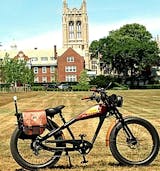
Maintenance tips for electric bikes
Proper maintenance and care of your e-bike can improve its performance, extend its lifespan, and prevent costly repairs down the road. Here are some maintenance tips for e-bikes:
- Read the owner's manual: The owner's manual provides important information about the maintenance and care of your e-bike. Read it carefully and follow the manufacturer's recommendations. The manual will explain all components of the bike, give your trouble-shooting ideas, as well as provide maintenance tips specific to your bike.
- Clean your e-bike regularly: Regular cleaning will prevent rust and corrosion. Use a soft cloth to wipe down your bike after every use, especially if you ride in rain or snow. Use a mild detergent and water, along with a soft brush or cloth, to clean the frame, components, and drivetrain. Make sure that the chain, cassette and derailleur are especially clean. Avoid petroleum or alcohol-based products because these products can damage paint and rubber seals. Avoid using a pressure washer, as it can damage your bike's components
- Check tire pressure: Check your tire pressure regularly and keep your tires in good condition. Proper tire pressure will improve your bike's performance and prevent flats. Ideally, keep your tire pressure above 50-55 PSI. If the rider weighs more than 200lbs, then aim for 60 PSI. Be sure to check your tires for a max PSI setting and do not not exceed it.
- Inspect the brakes: Inspect your brakes regularly for wear and tear. Replace brake pads and rotors when they become worn and adjust the brake cables as needed. Adjust the brake calipers if needed to maintain proper braking performance. If you notice any squealing or ineffective braking, it may be necessary to replace the brake pads or have them professionally serviced. Keep the brake pads free of debris to maintain your maximum braking power. Check that your disc is not rusted, bent, or scratched. Lift the front of your bike, spin the wheel, and then pull on the brake lever to check the wheel stops quickly and firmly. Lift the back of your bike and repeat.
- Maintain the battery and protect from weather elements: Regularly charge your batteries and keep them clean and dry. Avoid completely draining the battery regularly. Storing the bike at low charge levels reduces the battery's storage capacity. Do not expose the battery to extreme temperatures, as this can damage the battery. Yes, you may ride through puddles or get caught in the rain. However, it is not advisable to leave your eBike out in the rain for long periods of time...or even leaving it out in the sun. Whenever possible, keep your eBike in the house to avoid extreme temperatures or harsh weather.
-
Keep the chain clean, lubed, and tensioned: A clean and well-lubricated chain will improve your bike's performance and prevent wear and tear, especially on other components like gears and cassettes. Proper chain tension is important for the smooth and efficient operation of an electric bike. The ideal tension for an eBike chain depends on the specific type of drivetrain and the recommendations of the eBike manufacturer.
The manufacturer's instructions will provide the most accurate and reliable information to ensure optimal performance and to prevent premature wear on the chain and other drivetrain components. If you are unsure or uncomfortable adjusting the chain tension yourself, it is recommended to take your eBike to a qualified bike mechanic or eBike specialist who can assist you in properly setting the chain tension according to your eBike's specifications.
Here are some general guidelines:
a. Single-speed or internally geared eBikes: For eBikes with a single-speed or internally geared hub drivetrain, the chain tension should be adjusted so that it has a slight amount of slack but is not excessively loose. When properly tensioned, you should be able to push down on the chain midway between the front and rear sprockets and lift it off the drivetrain by approximately 0.5 to 1 centimeter (0.2 to 0.4 inches).
- b. Derailleur-equipped eBikes: If your eBike has a derailleur drivetrain, the chain tension is primarily controlled by the rear derailleur's spring tension. In this case, it is important to follow the manufacturer's recommendations for setting the proper tension. Typically, the chain should be taut enough to prevent excessive slack or sagging but not so tight that it puts excessive strain on the drivetrain components.
-
7. Lubricate all pivot points, bearings, and bushings: Lubricate all moving parts of your e-bike to prevent wear and tear and improve performance. This helps reduce friction, prevents rust, and extends the life of these parts. Wipe off any excess lubricant to avoid attracting dirt and debris. When selecting lubricants for your eBike, ensure they are compatible with the materials and components of specific eBike model. After refer to the manufacturer’s recommendations and instructions for the appropriate lubricants to use on your eBike.
-
8. Pay attention to the controls and accessories: Check the controls and accessories of your e-bike regularly to ensure they are working properly. Replace any damaged or worn parts
-
9. Maintain the electric bike motor: Keep the motor clean and free of debris. Check the motor for wear and tear and replace any damaged parts. Be mindful of weight and load: Electric bike motors have weight and load limits specified by the manufacturer. Avoid exceeding these limits, as it can strain the motor and lead to premature wear or damage. Be mindful of carrying heavy loads or towing objects that may put undue stress on the motor.
-
10. Regularly inspect and adjust bolts: Check all the bolts and screws on your e-bike to ensure they are tightened properly. Pay particular attention to the stem, handlebars, seatpost, and any accessories you may have installed. Loose bolts can affect the bike's stability and safety.
-
11. Suspension maintenance: If your e-bike has suspension forks or rear suspension, follow the manufacturer's recommendations for maintenance. Regularly clean and inspect the suspension components, and have them serviced or repaired by a professional if necessary.
-
12. Examine electrical connections: Periodically check the electrical connections on your e-bike, including the battery connections and wiring. Look for fraying or wear to the outer casing. Ensure they are secure and free from dirt or corrosion. If you notice any loose connections or damage, consult the manufacturer or a qualified technician for assistance.
-
13. Take it to an e-bike shop: If you're unsure about the maintenance of your e-bike, take it to an e-bike shop. A professional mechanic can help you with any problems or questions and provide the necessary maintenance for your e-bike







Leave a comment